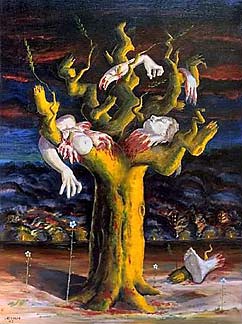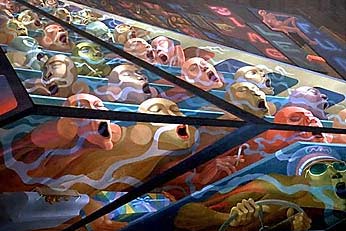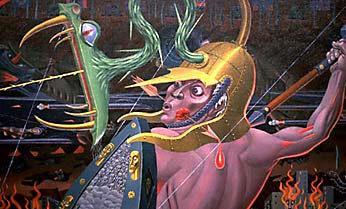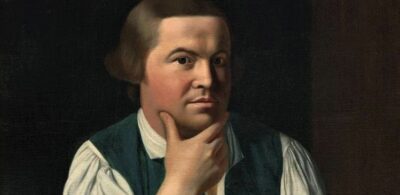The Social Surrealism of Irving Norman
Dark Metropolis: Irving Norman’s Social Surrealism, is an extremely important exhibition of paintings that will be on view at the Nora Eccles Harrison Museum of Art in Logan, Utah, starting June 5th, 2007. Until his death in 1989, Irving Norman had painted in California since the early 1940’s – and my having discovered the art works of the brilliant artist only a few years ago is a testament to the state of a blinkered art world. The irony of my discovery is that it wasn’t facilitated by a fellow artist or an art historian, critic or journal, but by a political activist who wrote to me one day in November of 2003 to ask if I had ever heard of the painter. Embarrassed by my unfamiliarity with the artist, I did a bit of research on Norman and was astounded at what I found.
Michael Duncan, a curator of contemporary art and corresponding editor for Art in America, wrote a July 2003 article for that magazine in which he described the paintings of Norman as “jaw-droppingly effective social indictments that would have been endorsed by Orwell and Huxley. The unrestrained passion and monumental energy of this work blows most contemporary political art out of the water.” Duncan’s remark is no understatement – all the works of today’s supposed “guerilla artists” who’ve made careers out of radical posturing, look feeble compared to those of Norman, especially when one considers the personal sacrifices he made in pursuit of his art.

An émigré from Poland in 1923, Norman first lived on New York’s Lower East Side before settling in Los Angeles in 1934. In 1938 he joined the American Abraham Lincoln Brigade, part of the international brigades who fought to save the Spanish Republic from fascism in the Spanish Civil War. Norman’s experiences in that conflagration not only shaped his world view, they inspired him to become a painter. Returning to the states in 1939, he enrolled in art school and by 1941 had a solo exhibit of drawings at the San Francisco Museum of Art. Norman’s works began to garner praise in the press, even though his drawings and paintings portrayed troublesome realities. In 1946 he would study with Social Realist Reginald Marsh in New York City and travel to Mexico to see the works of the Mexican Muralists, David Alfaro Siqueiros, Diego Rivera, and José Clemente Orozco.
Although influenced by the Social Realists of his time, Norman’s style of figuration was set apart by a predilection for caricature – a realism inflamed by the fantastic rather than the natural. The horror and futility of war as experienced by the artist in Spain certainly equipped him with an apocalyptic vision. Norman was creating meticulously detailed realistic paintings and making use of “cartoon” aesthetics decades before the advent of Photorealism or the current “low-brow” fad as exemplified in magazines like Juxtapoz. But unlike those genres, Norman’s gripping critical visions possess a knife-edge clarity, empathy, and non-pretentiousness – a seriousness and compassion for humanity not found in the postmodern.

You’d think that an artist as talented and dedicated to painting as Norman would have been on the fast track to success, but in late 1940’s America two portentous trends were about to sideline the artist’s works to obscurity – McCarthyism and Abstract Expressionism. In the introduction to the excellent catalog book, Dark Metropolis, Scott A. Shields, Chief Curator of the Crocker Art Museum in Sacramento, wrote:
To FBI director J. Edgar Hoover, the link between the Communist Party and the Spanish Civil War made all veterans of the Abraham Lincoln Brigade suspect of potential disloyalty. With the approval of President Roosevelt, Hoover ordered the surveillance of all ‘subversive activities,’ which included the investigation of propaganda ‘opposed to the American way of life’ and the oversight of agitators who aroused ‘class hatred.’ Veterans of the Abraham Lincoln Brigade were promptly put under surveillance by the federal investigators. Many were blatantly harassed at home and at work, both in person and by telephone, and many lost their jobs and faced occupational blacklists.
Hela Norman believes that her husband was the victim of such a blacklist. ‘Curators and museum directors would come to visit and were jumping up and down they were so excited by the work,’ she remembered. ‘They would promise to purchase work and host museum exhibits – and then nothing. We would never hear from them again.’ The FBI files obtained through the Freedom of Information Act confirm that Norman’s activities were heavily monitored and perhaps stifled. The degree to which these government activities negatively impacted Norman’s stature as an artist may never be known. Entire pages of the FBI files are redacted. Those pages that are legible include clear documentation that Norman’s career and progress were closely tracked by the government for over twenty years, beginning in the early 1950’s, first by FBI agents and then by the United States Postal Service.
(….) The harassment of the Normans became so great that in 1958 the couple sought the assistance of the American Civil Liberties Union, which successfully persuaded the FBI to stop their visits and interrogations. However, the Postal Service continued its surveillance until 1974, when Norman’s file finally stopped growing. Hela Norman remembers the FBI’s last visit, when an agent told Irving, ‘We consider you unfriendly.'”
But government repression was perhaps the lesser of Norman’s problems, because by the late 1940’s figurative realism fell out of fashion and gave way to the detached and non-narrative world of abstract color field painting. Adam Gopnik, a writer for New Yorker magazine, described the dominance of abstract art during this period in the following manner: “Oversized abstract watercolors had become the single style of the American museum, forcing two generations of realists to live in basements and pass still-lifes around like samizdat.” By the late 1950’s abstract expressionism had become what could only be described as art official, and there was little room in the art world for those who contested the canon of conformity. Under these conditions Irving Norman worked in isolation, heroically painting gigantic canvasses in his studio that flew in the face of prevailing tastes as dictated by art elites. As modern art grew empty to the point of meaninglessness, Norman’s tremendously detailed and defiantly humanist paintings screamed the nightmares of modern society. Though it’s true the artist had a small circle of supporters, especially in the San Francisco Bay area where he lived and worked, it’s also a matter of fact that he was largely ignored by the art establishment.

In retrospect, the shunning of Irving Norman seems wholly ridiculous. The stylistic tyranny of abstract expressionism is thankfully but a memory, and a socially engaged artist is no longer thought of as an eccentric in the arts community. It seems the art world has at last caught up with Norman’s vision – or has it? The so-called pluralism of today’s postmodern art scene makes room for the type of outsider art Norman championed decades ago; but given contemporary art’s present flight from social responsibility, it’s more than likely that Norman’s aesthetics will be embraced – while his humanistic vision and belief in art as a force for social change will be ignored. That being the case, there is much work to be done in preserving Norman’s legacy.


Irving Norman deserves not only to be a recognizable name, but a lauded one. The Dark Metropolis traveling exhibit and catalog are blazing steps in the right direction, both should be given full support, and hopefully they’ll lead to further exhibits, retrospectives, academic attention, and public awareness. But most importantly, these social surrealist works should provide inspiration to contemporary artists, who with any luck – will pick up Irving Norman’s banner and run with it.
Dark Metropolis: Irving Norman’s Social Surrealism, will next show at the Nora Eccles Harrison Museum in Logan, Utah, where it will run from June 5th, 2007 to October 20th, 2007. After that the exhibit will travel to the Katzen Arts Center at American University in Washington, D.C., where it will show from November 13th, 2007 to January 23rd, 2008. The show at the Katzen should be especially interesting since the Abu Ghraib paintings of Fernando Botero will be exhibited there during the same time frame (Nov. 6th – Dec. 30th, 2007 – a show not to be missed! ) For those unable to attend these exhibits, be sure to visit www.irvingnorman.com, the official and very informative website maintained by the artist’s estate. The beautifully illustrated and enlightening catalog book, Dark Metropolis: Irving Norman’s Social Surrealism, is available from Amazon.com.




